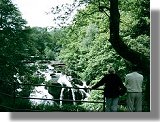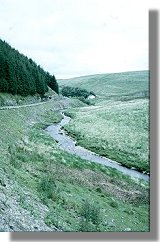|
Future
 Our deep appreciation of river systems is reflected in the growing number of rivers being recognized for their historic and nature conservation importance. In Wales, several river valleys, including the Wye, Tywi and Conwy, are included in a register of historic landscapes. In particular, these river valleys offered impressive scenic locations for country houses and estates. Rivers have also been designated as Sites of Special Scientific Interest for their nationally important bio- and geo-diversity. Eight Welsh rivers have been included in the Natura 2000 network of sites which extends across Europe and seeks to protect internationally threatened habitats and species, including water crowfoot rivers, otters, salmon and freshwater pearl mussel. This type of recognition acts as the insurance policy for their future protection as they are given special consideration in the context of development plans. Our deep appreciation of river systems is reflected in the growing number of rivers being recognized for their historic and nature conservation importance. In Wales, several river valleys, including the Wye, Tywi and Conwy, are included in a register of historic landscapes. In particular, these river valleys offered impressive scenic locations for country houses and estates. Rivers have also been designated as Sites of Special Scientific Interest for their nationally important bio- and geo-diversity. Eight Welsh rivers have been included in the Natura 2000 network of sites which extends across Europe and seeks to protect internationally threatened habitats and species, including water crowfoot rivers, otters, salmon and freshwater pearl mussel. This type of recognition acts as the insurance policy for their future protection as they are given special consideration in the context of development plans.
The long history of the scientific study of rivers in Wales leaves us with a pretty good understanding of the physical, chemical and biological processes involved. The biggest challenges for the future of Welsh rivers will be to restore past environmental damage, continue to monitor their health and to find a balance between human demands for water. River restoration projects are underway, with meanders being reinstated; streamside fencing is allowing regrowth of natural vegetation and buffering the effects of pollution; and fish ladders are being installed into barriers (see side bar). The Environment Agency continues to control water pollution and reports improvements in water quality. It is true to say that many of our rivers are much cleaner than they were a hundred years ago but our understanding of what is a clean or healthy river is being challenged by scientific developments. Exciting new European Union legislation is asking us to judge and monitor the ecological quality of rivers, moving us away from focusing on pollution and taking into account the physical structure of rivers and their biodiversity. Has the river been dredged and straightened? Is it still connected with it floodplain? How close are the plant and animal communities to those that would be found in completely natural conditions?
 Rivers will not be immune to future climate change concerns. It is clearly evident that rivers have responded to past changes in climate and remain extremely sensitive to future changes in temperate and rainfall, which are two of the main environmental pressures being predicated under climate change scenarios. It can therefore be expected that riverine wildlife will respond to significant changes in weather patterns, with key species changing their distribution and abundance. The latest research carried out in the uppermost streams of the Tywi River, South Wales, has shown that these shallow streams have increased in temperature over the past 25 years. However, ecologists are still trying to disentangle the biodiversity effects of climate change from the lasting impact of acid rain. Rivers will not be immune to future climate change concerns. It is clearly evident that rivers have responded to past changes in climate and remain extremely sensitive to future changes in temperate and rainfall, which are two of the main environmental pressures being predicated under climate change scenarios. It can therefore be expected that riverine wildlife will respond to significant changes in weather patterns, with key species changing their distribution and abundance. The latest research carried out in the uppermost streams of the Tywi River, South Wales, has shown that these shallow streams have increased in temperature over the past 25 years. However, ecologists are still trying to disentangle the biodiversity effects of climate change from the lasting impact of acid rain.
It is certain that rivers will continue to be utilized for a multitude of functions – fishing, canoeing, drinking water, energy generation – but we all need to ensure that they are appreciated as a critical natural resource which has to be conserved and managed wisely.
Read more in The Rivers of Wales
|